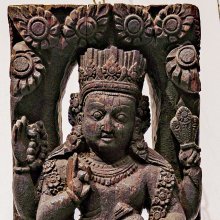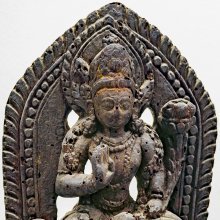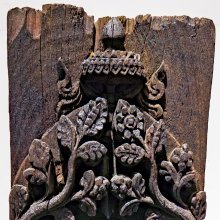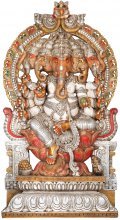Wood: 3 definitions
Introduction:
Wood means something in Hinduism, Sanskrit. If you want to know the exact meaning, history, etymology or English translation of this term then check out the descriptions on this page. Add your comment or reference to a book if you want to contribute to this summary article.
Images (photo gallery)
(+87 more images available)
In Hinduism
Natyashastra (theatrics and dramaturgy)
Source: Shodhganga: Elements of Art and Architecture in the Trtiyakhanda of the Visnudharmottarapurana (natya)Wood is used as a material for creating artificial masks (of gods, demons, animals, etc.) in Indian Dramas, as part of the Prasta division of Āhāryābhinaya: one of the four divisions of Abhinaya or “ways to convey or represent one’s emotion to others”, according to the Viṣṇudharmottarapurāṇa, an ancient Sanskrit text which (being encyclopedic in nature) deals with a variety of cultural topics such as arts, architecture, music, grammar and astronomy.—The Viṣṇudharmottarapurāṇa says that Prasta denotes the making of artificial masks of gods, demons, demi-gods, different animals and birds etc. by clay, wood, cloth, leather and iron. In the Nāṭyaśāstra, the word pusta is used instead of prasta.

Natyashastra (नाट्यशास्त्र, nāṭyaśāstra) refers to both the ancient Indian tradition (shastra) of performing arts, (natya—theatrics, drama, dance, music), as well as the name of a Sanskrit work dealing with these subjects. It also teaches the rules for composing Dramatic plays (nataka), construction and performance of Theater, and Poetic works (kavya).
Vastushastra (architecture)
Source: Shodhganga: Elements of Art and Architecture in the Trtiyakhanda of the Visnudharmottarapurana (vastu)Wood represents an important Material for the Construction of Temples, which was carefully gathered from the forest, according to the Viṣṇudharmottarapurāṇa, an ancient Sanskrit text which (being encyclopedic in nature) deals with a variety of cultural topics such as arts, architecture, music, grammar and astronomy.—Finding of proper types of materials is one of the important aspects for any construction. In the Viṣṇudharmottarapurāṇa, the architect is suggested to go to the forest to collect appropriate wood for temples in an auspicious day after taking advice from an astrologer. The woods of the trees which are hollow from inside, which bear creepers, which are eaten by worms, slightly burnt by fire, ruined by wind are totally discarded for making temples. [...] After collecting the suitable wood from forest, the architect uses it according to his requirements and purposes.

Vastushastra (वास्तुशास्त्र, vāstuśāstra) refers to the ancient Indian science (shastra) of architecture (vastu), dealing with topics such architecture, sculpture, town-building, fort building and various other constructions. Vastu also deals with the philosophy of the architectural relation with the cosmic universe.
Yoga (school of philosophy)
Source: ORA: Amanaska (king of all yogas): A Critical Edition and Annotated Translation by Jason Birch(A piece of) Wood is denoted by the Sanskrit term Kāṣṭhavat, according to the Amanaska Yoga treatise dealing with meditation, absorption, yogic powers and liberation.—Accordingly, as Īśvara says to Vāmadeva: “[...] [Now], I shall define the nature of that highest, mind-free absorption which arises for those devoted to constant practice. [...] And [that Yogin] is neither alive nor dead, does not see nor close his eyes. He remains lifeless like a piece of wood (kāṣṭhavat) and [thus] is said to be abiding in absorption. [...]”.

Yoga is originally considered a branch of Hindu philosophy (astika), but both ancient and modern Yoga combine the physical, mental and spiritual. Yoga teaches various physical techniques also known as āsanas (postures), used for various purposes (eg., meditation, contemplation, relaxation).
See also (Relevant definitions)
Starts with (+32): Wood anemone, Wood apple, Wood aster, Wood avens, Wood bluegrass, Wood calamint, Wood cotton tree, Wood flower, Wood garlic, Wood iris, Wood larkspur, Wood lily, Wood meadow grass, Wood of the gods, Wood rose, Wood shaving flower, Wood sorrel, Wood sparrow, Wood strawberry, Wood-nettle.
Ends with (+414): Acajou wood, African blackwood, African coral wood, African ironwood, African rosewood, African sandalwood, African satinwood, African stainwood, African wormwood, African yellow wood, Agarwood, Alaska wormwood, Alligator wood, Aloeswood, Aloewood, Alternate-leaf dogwood, Amboyna-wood, American basswood, American dogwood, Andaman redwood.
Full-text (+4022): Kashtha, Daru, Candana, Kapittha, Arani, Aguru, Kaliyaka, Bilva, Khadira, Haricandana, Agaru, Cangeri, Ghuna, Vanecara, Ardrakashtha, Darava, Vaneshaya, Aranyaka, Pailava, Kripita.
Relevant text
Search found 353 books and stories containing Wood; (plurals include: Woods). You can also click to the full overview containing English textual excerpts. Below are direct links for the most relevant articles:
Yoga Vasistha [English], Volume 1-4 (by Vihari-Lala Mitra)
Chapter CXCVI - Story of a wood-cutter and his gem < [Book VII - Nirvana prakarana part 2 (nirvana prakarana)]
Chapter XX - Remonstration of pavana < [Book V - Upasama khanda (upashama khanda)]
Chapter CIV - On the conduct of living-liberated men < [Book VI - Nirvana prakarana part 1 (nirvana prakarana)]
Puppetry in Assam (by Gitali Saikia)
Craftsmanship: Puppet making process of Assam < [Chapter 4]
Puppetry in satras (monasteries) of Majuli < [Chapter 4]
Chapter 5: Comparative Study Of Indian Puppet And Assam’s Puppet
Kaka’s Song of the Woods < [October – December, 1986]
The Poet < [October 1947]
Triple Stream < [April – June and July – September, 1996]
Bharadvaja-srauta-sutra (by C. G. Kashikar)
Ramayana of Valmiki (by Hari Prasad Shastri)
Chapter 48 - Angada slays an Asura < [Book 4 - Kishkindha-kanda]
Chapter 80 - A royal highway is constructed for the prince < [Book 2 - Ayodhya-kanda]
Chapter 55 - Shri Rama, Sita and Lakshmana cross the Yamuna and travel on < [Book 2 - Ayodhya-kanda]
Vinaya (3): The Cullavagga (by T. W. Rhys Davids)
Cullavagga, Khandaka 8, Chapter 6 < [Khandaka 8 - Regulations as to the Duties of the Bhikkhus towards one Another]
Cullavagga, Khandaka 5, Chapter 32 < [Khandaka 5 - On the Daily Life of the Bhikkhus]
Cullavagga, Khandaka 6, Chapter 1 < [Khandaka 6 - On Dwellings and Furniture]
Related products
(+30 more products available)











